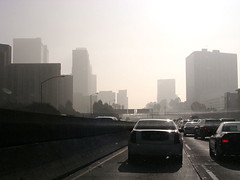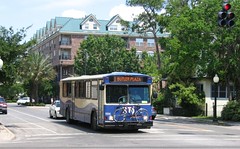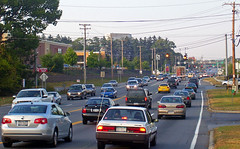Smart growth improves air quality, says new research

Posted May 7, 2008 at 6:41PM
The federal Environmental Protection Agency has released important new research detailing the benefits of smart growth on transportation emissions and air quality.
 In particular, the report reviews the effects on traffic and pollution that would occur if new growth and land development were encouraged to take place on vacant parcels and redevelopment sites within established cities and suburbs, instead of sprawling out onto sites that are now farmland or forests. The report also examines the potential benefits of developing near public transportation and on obsolete industrial "brownfield" sites.
In particular, the report reviews the effects on traffic and pollution that would occur if new growth and land development were encouraged to take place on vacant parcels and redevelopment sites within established cities and suburbs, instead of sprawling out onto sites that are now farmland or forests. The report also examines the potential benefits of developing near public transportation and on obsolete industrial "brownfield" sites.
Written by EPA’s Smart Growth Program, Measuring the Air Quality and Transportation Impacts of Infill Development concludes:
“Fundamentally, well designed neighborhoods in more accessible places make walking, biking and transit more convenient options. Therefore, policies that increase the amount of urban and suburban infill development can help more people meet their everyday needs with less driving. In turn, this can reduce traffic and contribute to better regional air quality . . .
 “This study illustrates how regions can calculate these benefits. The basic approach relies upon standard transportation forecasting models currently used by Metropolitan Planning Organizations across the country. The results suggest that strong support for infill development can be one of the most effective transportation and emission reduction investments regions can pursue . . .
“This study illustrates how regions can calculate these benefits. The basic approach relies upon standard transportation forecasting models currently used by Metropolitan Planning Organizations across the country. The results suggest that strong support for infill development can be one of the most effective transportation and emission reduction investments regions can pursue . . .
“Across the three case studies, redirecting jobs and households to brownfield and other infill sites reduces overall travel, congestion and emissions from cars. For example, if just 8 percent of Denver’s jobs and households were shifted over time toward 10 regional centers, congestion would be reduced by over 6 percent and emissions would be reduced by about 4 percent. This would be equivalent to removing nearly half a million trips per day from the region’s roads, a significant share of the daily average (12.7 million miles). If the same amount of development was concentrated in 31 locations, the reduction in emissions would be somewhat smaller (3 percent).
“The Charlotte case study evaluated the impact of increased infill development in a single corridor. Although a much smaller number of jobs and homes were relocated to infill sites, the analysis demonstrates the benefits of focused development around transit. While the new rail service alone did reduce congestion in the corridor, it had a minimal impact on the region’s emissions.  However, when 16,000 households and 10,000 jobs are relocated near the South Corridor stations, the reduction in emissions was 10 times greater and transit ridership increased by more than 6,000 trips each day.
However, when 16,000 households and 10,000 jobs are relocated near the South Corridor stations, the reduction in emissions was 10 times greater and transit ridership increased by more than 6,000 trips each day.
The full, 77-page report may be found here. It confirms and expands a growing body of research on land use and transportation, including last month's release of a major study documenting how smart growth reduces global warming emissions.